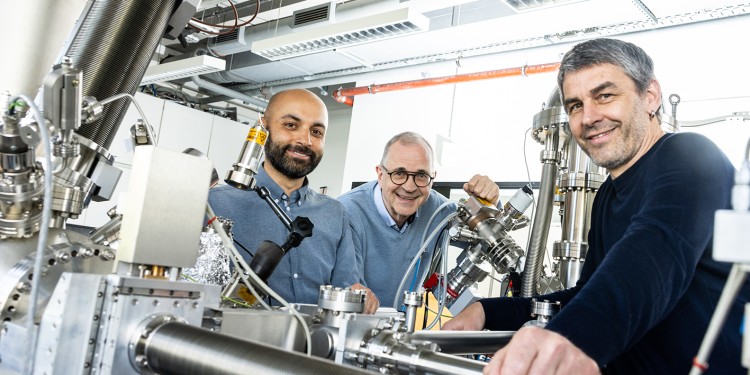
Where the borders between disciplines become blurred
The area where physics and chemistry meet lies somewhere in the realm of the minute – in the nano range: where molecules react with one another and the laws of quantum mechanics hold sway. This is the area which physicist Dr. Harry Mönig visualises at the Center for Nanotechnology (CeNTech) – with an atomic force microscope and a dedicated technology perfected by himself and a Münster team. In this technology, an atomic-sized probe made of copper scans the surface pf the sample; an oxygen atom at the tip prevents any unwanted interactions from occurring. This method makes it possible to analyse molecules, their structures and networks, and the interactions between the molecules. The physicists can even identify different atoms.
“We study metal oxide surfaces, for example, which are extremely important in catalytic chemistry,” says Harry Mönig, who works with chemists in various research projects relating to surface chemistry. “We want to understand in detail where and how chemical reactions there occur at the atomic level.” Mönig was involved in a study in which so-called single-atom catalysts can be characterised at atomic resolution and investigated for their electrochemical properties. Catalysts play a central role in countless chemical reactions. Among other things, they make it possible for chemical energy to be converted into electricity in fuel cells. So in which discipline does Harry Mönig carry out his research? In chemistry or in physics? “I can’t tell you,” he replies.
One of the pioneers working in that area between chemistry and physics is Prof. Harald Fuchs, who heads the Nano- and Interfacial Physics working group at the University of Münster and is the Scientific Director at CeNTech. From the mid-1980s onwards, Fuchs, a senior professor, helped to shape the incipient first collaborations in Europe between teams working in the fields of chemistry and physics in the area of the nano-sciences – initially as a group leader at BASF. In his pioneering work there, he established scanning tunnelling microscopy for studying molecular systems – one of the first applications worldwide of what was then a new method. At the University of Münster too, where he has been teaching and researching since 1993, he works closely with several working groups from the field of chemistry, including in particular the groups headed by Prof. Gerhard Erker, Prof. Armido Studer and Prof. Frank Glorius.
“We work especially in the field of chemical surface reactions,” says Fuchs. “We can create and visualise compounds which cannot be produced by traditional methods in a test tube or in the gas phase. By applying our physical methods, as well as new theoretical ones, we can watch the course of such reactions, so to speak, and understand them in detail. In this way, we can demonstrate new paths of development for synthesis and new types of functional properties.” Examples of this, says Fuchs, are the production of certain polymers which are otherwise difficult to synthesise, or the energy-saving activation of (often inert) carbon-hydrogen bonds. “It is also possible,” he adds, “to produce organometallic compounds which are able to specifically remodel the atomic structure of certain surfaces without any further external influence.”
Chemistry or physics? Perhaps it really isn’t possible to draw a clear distinction. This, at any rate, is the conclusion which physical chemist Dr. Saeed Amirjalayer comes to. His pet projects involve not only processes which occur in the nano-range, but also the question of how these processes can be controlled. What interests him is how functional materials can be activated and deactivated. When is, or isn’t, a molecule catalytically active? When does, or doesn’t, it emit light? When can a molecular machine be controlled in such a way that it delivers a specific active substance? Saeed Amirjalayer is developing theoretical methods, applying them in order to simulate, at the computer, molecular processes in the so-called responsive functional materials. In his work he is in close contact with experimenters in both disciplines and has been collaborating with Harald Fuchs and Harry Mönig for years. “We have shown in an interdisciplinary team that the chemical properties – and thus the chemical reactivity – of a molecule can change if it is pulled at. In this case, the physical tensile forces have a similar effect to a catalyst.” As Amirjalayer points out: “These results show once again that for most questions there is no clear distinction between chemistry and physics – and that closer cooperation between the disciplines is therefore decisive.”
Background:
At the University of Münster, researchers from the Natural Sciences and the Life Sciences work together in the field of Nano-sciences. The Center for Nanotechnology (CeNTech), a joint institution of the University and the City of Münster, provides the infrastructure – office space and laboratories – for cooperation between members of the Faculties of Chemistry and Pharmacy, Physics, Biology and Medicine. This interdisciplinary collaboration can also be seen in the Center for Soft Nanoscience (SoN) at the University of Münster. SoN is home to 28 working groups from the Natural Sciences and the Life Sciences.
Author: Christina Hoppenbrock
This article is from the university newspaper wissen|leben No. 3, 3 May 2023.
